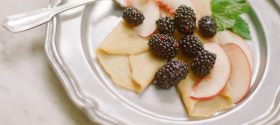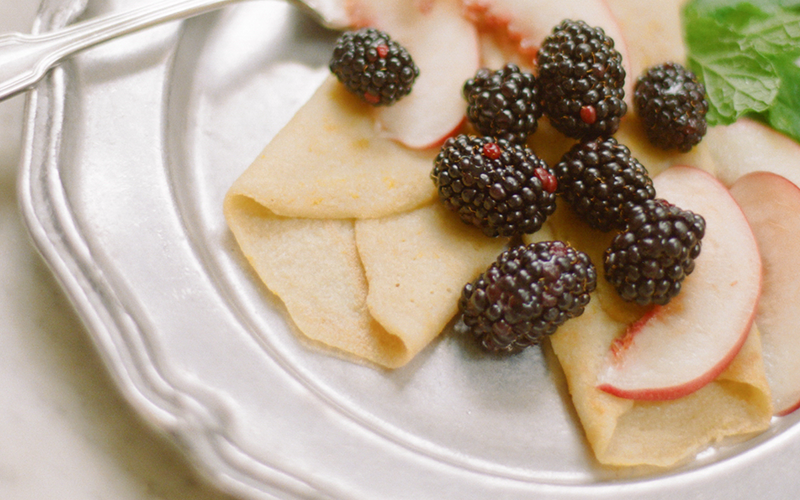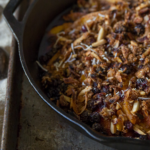Two of my favorite things in the world are paleo breakfasts, specifically paleo pancakes. Thanks to Diana Rodgers brand new book The Homegrown Paleo Cookbook, now you can have what I call fancy pancakes. Also known as Lemon Crepes with Blackberries and Peaches. You know a recipe is delicious when it has that little squiggly letter thing above the e in crepes. Besides this recipe for Lemon Crepes, this book is phenomenal and loaded with amazing information.
Fancy Paleo Pancakes (Lemon Crepes)
To describe The Homegrown Paleo Cookbook as just a cookbook is an understatement. Yes, it is a cookbook with over 100 seasonal farm-to-table recipes that fit within a Paleo template as well. In addition, there references boxes for each recipe that offer Whole30, nut-free, egg-free, and AIP substitution options. However, The Homegrown Paleo Cookbook is so much more than just delicious, seasonally-sourced recipes; it will teach you to be a better, more responsible consumer. Since I am a food blogger though, I have to share a few of the recipes in the book:
- Lemon Crepes with blackberries and peaches (posted here)
- Spring egg drop soup with lemon-ginger meatballs
- Almond Panna Cotta
- Cinnamon Basil Breakfast Sausage
- Curry Hash
- Hard Cider
The first half of The Homegrown Paleo Cookbook is about getting your hands dirty by raising your own animals and growing your own food. Yet, The Homegrown Paleo Cookbook is not just for the homesteader – even though it is a fantastic resource for those who are interested in it – but for anyone who wants to know where food comes from and understand sustainability. Even if you live in a big city with just a balcony for outdoor space (hint: there is a section about growing vegetables and herbs in containers) or simply have no desire to raise backyard chickens or have a bee colony, you will learn about sustainable food production, which is critical in today’s world of factory-farmed and pesticide-covered food supply.
What you can do right now to support sustainability:
- Cook. Whether you are just learning to cook or are an experienced chef, use locally grown produce or locally raised meat in all of your cooking. Cooking is the most basic way that you can support sustainability.
- Grow Your Food. Whether you just have a windowsill or acres of land, grow something. From a potted herb plant to a huge backyard garden, anything you grow yourself will taste better and be more cost-effective than anything store bought.
- Buy locally. If you cannot raise it or grow it, buy meat and produce locally at farmer’s markets or join a CSA (community supported agriculture). This keeps money in your community as well as support local farmers.
- Eat seasonally. Eat fruits and vegetables when they are in season and more abundant. Also, fruits and vegetables that are in-season are much more flavorful and cheaper than they are when out-of-season.
- Buy grass-fed or pastured meat. If you cannot buy meat from a local farmer, buy responsibly at the grocery store. While “grass-fed” and “pastured” does not guarantee that the animals were raised ethically, more than likely they were treated better than animals raised in CAFOs (Concentrated Animal Feeding Operations).
- Buy fair-trade. If you must buy imported foods, make sure it is labelled as “Fair Trade,” “Authentic Fair Trade,” or “Direct Fair Trade” to help ensure safe and sustainable agricultural practices in developing countries.
- Buy sustainable seafood. The oceans are being depleted of fish due to commercial overfishing. Go to The Monterey Bay Aquarium’s Seafood Watch website for up-to-date information about which seafood and fish are sustainable and ideal to buy.
- Make convenience foods. Instead of buying prepackaged bone broth, mayonnaise, ketchup, etc., make your own. There is no need to buy a factory-made product that you can make instead. There are tons of options here.
- Preserve food. Can, ferment, freeze and dehydrate your homegrown or locally-sourced produce in order for it to last for several seasons.
- Protect the bees. Buy honey from local beekeepers to help support their hives. Stop spraying pesticides on your lawns, and grow native flowering plants (especially those with pink, purple and yellow blooms).
I am glad I got to share with you a small snippet from this gem of a book. I would keep typing but know you will enjoy these lemon crepes with blackberries and peaches more than my writing. I encourage you to pick up a copy of this book immediately here and then go enjoy these delicious lemon crepes.

Lemon Crêpes with Blackberries and Peaches
Ingredients
- 2/3 cup tapioca starch
- 1/3 cup coconut flour
- 1/4 teaspoon baking soda
- 1/2 teaspoon sea salt
- 2 eggs
- 1½ cups canned full-fat coconut milk
- 1 teaspoon vanilla extract
- Grated zest of 1 lemon
- 1 tablespoon melted coconut oil plus more for the pan
- Up to 1/2 cup water
- 1 cup blackberries
- 2 peaches white or yellow, sliced
- 1 tablespoon minced fresh mint leaves for garnish (optional)
Instructions
- In a large bowl, whisk together the tapioca starch, coconut flour, baking soda, and salt until blended.
- In a separate bowl, whisk together the eggs, coconut milk, vanilla, lemon zest, and coconut oil.
- Pour the wet ingredients into the dry ingredients and mix until thoroughly combined.
- Check the consistency of the mixture—it should be like a very thin pancake batter. Add up to 1/2 cup water if needed.
- Warm a skillet over medium heat.
- Melt a tablespoon of coconut oil in the pan, then, using a large spoon, pour in about 1/4 cup of the batter.
- Flip the crêpe after about 3 minutes, when the bottom is very lightly browned, and continue to cook for another 1 to 2 minutes.
- Transfer the finished crêpes to a warm plate and cover with a towel until ready to serve.
- Repeat with the rest of the batter, adding more coconut oil to the skillet if it becomes dry.
- To serve, place 2 or 3 crêpes on each plate and top with fresh blackberries and peach slices. Garnish with fresh mint, if desired.








 Meal Plans: Consciously Cutting Recipes in Half
Meal Plans: Consciously Cutting Recipes in Half
First time commenting here George, but long time reader and fan. Just had to write to say how absolutely delish these were. Just divine. I served mine with coconut whip and blueberries and my kid wrap bacon in his. :)
But serves 12? I just ate breakfast for six I think. Oops. :)
That may be a typo, I will adjust it :)
Just made them last night, the result was great but must admit I struggled a bit with consistency and cooking time.
With just 1/2 cup water, the batter was too thick and ended up adding 1 1/2 cup water in total to get it right. It needed to be added gradualy as the batter thickens constanly when sitting asside, suppose it’s because of the coconut flour.
Cooking time was long to get the crepe dry enough so I can flip it. First 2 ended up crumbled when not cooked enough. But if you cook enough it’s no problem to flip without breaking the crepe.
Thanks for the recipe, crepes were delicious! This time, I ate them with drizzle of maple syrup and lemon juice.
I really want to try this recipe, but I’m not sure if I can get tapioca starch. Do you think it can be substituted with arrowroot or something else?
I haven’t tested it but arrowroot in theory should work
Loved the crepes. Can they be frozen. Have many left over.
I think so. In theory they will work just fine like that
Is honey Paleo? I’m just starting my Paleo adventure and I wasn’t sure because it is a sweetener.
In the beginning you should avoid sweeteners, after 30 days you can reintroduce and see how you do. It really depends on your goals. If weight loss is a primary goal, leave it out.
Thanks! I’ve been trying to detox from sugar. I think I can do without sweeteners for 30 days:0)
I really wanna get my hands on this cookbook, such a great philosophy! And yum- crepes…